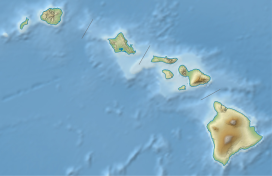Kohala
| Kohala | |
|---|---|

Kohala volcano as seen from Mauna Kea
|
|
| Highest point | |
| Elevation | 5,480 ft (1,670 m) |
| Prominence | 2,600 ft (790 m) |
| Coordinates | 20°05′10″N 155°43′02″W / 20.08611°N 155.71722°WCoordinates: 20°05′10″N 155°43′02″W / 20.08611°N 155.71722°W |
| Naming | |
| Pronunciation | Hawaiian pronunciation: [koˈhɐlə] |
| Geography | |
|
Hawaii, U.S.
|
|
| Parent range | Hawaiian Islands |
| Topo map | USGS Kamuela |
| Geology | |
| Age of rock | 700,000 years |
| Mountain type | Shield volcano, Hotspot volcano |
| Volcanic arc/belt | Hawaiian-Emperor seamount chain |
| Last eruption | About 120,000 years ago |
Kohala is the oldest of five volcanoes that make up the island of Hawaii. Kohala is an estimated one million years old—so old that it experienced, and recorded, a reversal of magnetic field 780,000 years ago. It is believed to have breached sea level more than 500,000 years ago and to have last erupted 120,000 years ago. Kohala is 606 km2 (234 sq mi) in area and 14,000 km3 (3,400 cu mi) in volume, and thus constitutes just under 6% of the island of Hawaii.
Kohala is a shield volcano cut by multiple deep gorges, which are the product of thousands of years of erosion. Unlike the typical symmetry of other Hawaiian volcanoes, Kohala is shaped like a foot. Toward the end of its shield-building stage 250,000 to 300,000 years ago, a landslide destroyed the northeast flank of the volcano, reducing its height by over 1,000 m (3,300 ft) and traveling 130 km (81 mi) across the sea floor. This huge landslide may be partially responsible for the volcano's foot-like shape. Marine fossils have been found on the flank of the volcano, far too high to have been deposited by standard ocean waves. Analysis indicated that the fossils had been deposited by a massive tsunami approximately 120,000 years ago.
Because it is so far from the nearest major landmass, the ecosystem of Kohala has experienced the phenomenon of geographic isolation, resulting in an ecosystem radically different from that of other places. Invasive species introduced by man present a problem to Kohala's ecosystem, as they push native species out of their habitat. There are several initiatives to preserve Kohala's ecosystem. Crops, especially sweet potato (Ipomoea batatas), have been harvested on the Leeward side of the volcano for centuries as well. The northern part of the island is named after the mountain, with two districts named North and South Kohala. King Kamehameha I, the first King of the Kingdom of Hawaii, was born in North Kohala, near Hawi.
...
Wikipedia

